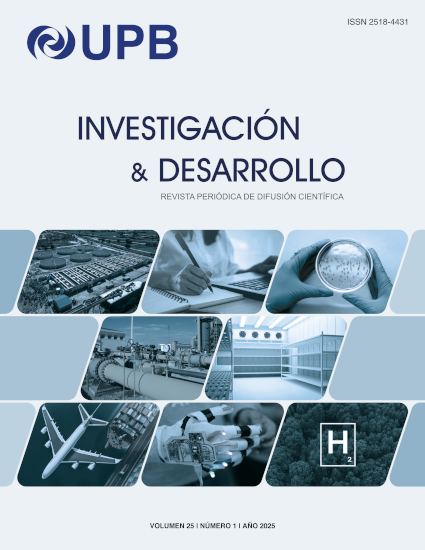BACTERIOTHERAPY IN ONCOLOGY: ADVANCES IN THE USE OF MICROORGANISMS TO OPTIMIZE THE ANTITUMOR IMMUNE RESPONSE
DOI:
https://doi.org/10.23881/idupbo.025.1-3iKeywords:
Bacteriotherapy, Immunotherapy, Cancer, Genetically Modified Bacteria, Oncological TreatmentAbstract
Cancer represents a significant global challenge due to its biological complexity, tumor heterogeneity, and the limitations of conventional therapies such as chemotherapy, radiotherapy, and certain immunotherapies, which often exhibit low specificity and considerable side effects. In this context, oncological bacteriotherapy has emerged as an innovative alternative within the field of immunotherapy, utilizing genetically modified bacteria to specifically target the tumor microenvironment. This review focused on analyzing the therapeutic potential of five bacterial species: Clostridium novyi-NT, Salmonella enterica serovar Typhimurium, Listeria monocytogenes, Escherichia coli, and Bifidobacterium longum, their mechanisms of action, efficacy, advantages, limitations, progress in preclinical and clinical studies, and their potential use in combination with other therapies. Additionally, an analysis of empirical data reported up to 2020 was conducted, identifying positive trends in success rates. Based on this, estimated projections for the 2025–2030 period was developed, outlining an optimistic yet realistic scenario that considers plausible clinical and statistical criteria to envision a future in which modified bacteria could become effective, customizable, and safe therapeutic tools. This study proposes and scientifically supports the value of bacteriotherapy as an emerging avenue for cancer treatment. By demonstrating tumor specificity, genetic engineering capabilities, and a low immunogenic profile, this work seeks to promote its development and clinical application.Downloads
References
[1] NIH, «Estadísticas del cáncer», Instituto Nacional del Cáncer, 7 de mayo del 2025, [En línea]. Disponible: https://www.cancer.gov/espanol/cancer/naturaleza/estadisticas.(Consultado 30 de mayo del 2025).
[2] X. Feng et al., «Novel insights into the role of Clostridium novyi‑NT related combination bacteriolytic therapy in solid tumors (Review)», Oncol. Lett., vol. 21, n.o 2, p. 110, dic. 2020, doi: 10.3892/ol.2020.12371.
[3] OPS, «Bolivia comprometida con la respuesta nacional del cáncer desarrolló acciones de validación y revisión de normas nacionales con expertos y especialistas», Organización Panamericana de la Salud, 24 de noviembre del 2024, [En línea]. Disponible: https://www.paho.org/es/noticias/28-11-2024-bolivia-comprometida-con-respuesta-nacional-cancer-desarrollo-acciones. (Consultado 2 de junio del 2025).
[4] K. H. Gupta, C. Nowicki, E. F. Giurini, A. L. Marzo, y A. Zloza, «Bacterial-Based Cancer Therapy (BBCT): Recent Advances, Current Challenges, and Future Prospects for Cancer Immunotherapy», Vaccines, vol. 9, n.o 12, p. 1497, dic. 2021, doi: 10.3390/vaccines9121497.
[5] T. K. Naranjo-Vela y D. A. Rosero-Freire, «Inmunoterapia en el cáncer», Rev. Peru. Cienc. Salud, vol. 5, n.o 3, pp. 238-248, oct. 2023, doi: 10.37711/rpcs.2023.5.3.420.
[6] K. B. Monterrozo Brán, «Inmunoterapia en el tratamiento del cáncer de mama», Rev. Cienc. Multidiscip. CUNORI, vol. 8, n.o 1, pp. 1-13, may 2024, doi: 10.36314/cunori.v8i1.246.
[7] F. Losa Gaspà, R. Legido Díaz, y S. Sánchez Pérez, «Cáncer de origen desconocido: diagnóstico, tratamiento y avances tecnológicos», Med. Clínica, vol. 165, n.o 5, p. 107118, nov. 2025, doi: 10.1016/j.medcli.2025.107118.
[8] A. Ezponda, «Urgencias oncológicas en radiología: cuadros clásicos y desafíos actuales».
[9] C. Lemus-Valdés y A. Padrón-Albertus, «Estrategias terapéuticas actuales en el tratamiento del cáncer de ovario», jul. 2023, doi: 10.5281/ZENODO.8148408.
[10] S. Singh, G.-H. Kim, K.-R. Baek, y S.-O. Seo, «Anti-Cancer Strategies Using Anaerobic Spore-Forming Bacteria Clostridium: Advances and Synergistic Approaches», Life, vol. 15, n.o 3, p. 465, mar. 2025, doi: 10.3390/life15030465.
[11] M. Luo, X. Chen, H. Gao, F. Yang, J. Chen, y Y. Qiao, «Bacteria-mediated cancer therapy: A versatile bio-sapper with translational potential», Front. Oncol., vol. 12, p. 980111, oct. 2022, doi: 10.3389/fonc.2022.980111.
[12] R. P. Aganja, C. Sivasankar, A. Senevirathne, y J. H. Lee, «Salmonella as a Promising Curative Tool against Cancer», Pharmaceutics, vol. 14, n.o 10, p. 2100, oct. 2022, doi: 10.3390/pharmaceutics14102100.
[13] J. Theys, A. V. Patterson, y A. M. Mowday, «Clostridium Bacteria: Harnessing Tumour Necrosis for Targeted Gene Delivery», Mol. Diagn. Ther., vol. 28, n.o 2, pp. 141-151, mar. 2024, doi: 10.1007/s40291-024-00695-0.
[14] J. Theys et al., «Repeated cycles of Clostridium-directed enzyme prodrug therapy result in sustained antitumour effects in vivo», Br. J. Cancer, vol. 95, n.o 9, pp. 1212-1219, nov. 2006, doi: 10.1038/sj.bjc.6603367.
[15] Y.-D. Ding et al., «Listeria monocytogenes: a promising vector for tumor immunotherapy», Front. Immunol., vol. 14, p. 1278011, oct. 2023, doi: 10.3389/fimmu.2023.1278011.
[16] Y. Zhang et al., «E. coli Nissle 1917-Derived Minicells for Targeted Delivery of Chemotherapeutic Drug to Hypoxic Regions for Cancer Therapy», Theranostics, vol. 8, n.o 6, pp. 1690-1705, 2018, doi: 10.7150/thno.21575.
[17] M. Sadeghi, D. Mestivier, y I. Sobhani, «Contribution of pks+ Escherichia coli (E. coli) to Colon Carcinogenesis», Microorganisms, vol. 12, n.o 6, p. 1111, may 2024, doi: 10.3390/microorganisms12061111.
[18] N. Daneshpour, «Bifidobacterium and the Immune System: A Key Player Against Gastrointestinal Cancers», J. Microbiota, vol. 1, n.o 3, oct. 2024, doi: 10.5812/jmb-154264.
[19] K. M. Dailey et al., «An intravenous pancreatic cancer therapeutic: Characterization of CRISPR/Cas9n-modified Clostridium novyi-Non Toxic», PLOS ONE, vol. 18, n.o 11, p. e0289183, nov. 2023, doi: 10.1371/journal.pone.0289183.
Downloads
Additional Files
Published
Issue
Section
License
Copyright (c) 2025 Mayra Fernanda Ocampo Valdivia, Sergio Andrés Cuiza Flores

This work is licensed under a Creative Commons Attribution-NonCommercial-ShareAlike 4.0 International License.
Creative Commons Attribution-Noncommercial-Share Alike
CC BY-NC-SA
This license lets others remix, tweak, and build upon your work for non-commercial purposes, as long as they credit the author(s) and license their new creations under the identical terms.
The authors can enter additional separate contract agreements for non-exclusive distribution of the version of the article published in the magazine (for instance, they may publish it in an institutional repository or a book), subject to an acknowledgement of its initial publication in this magazine.
